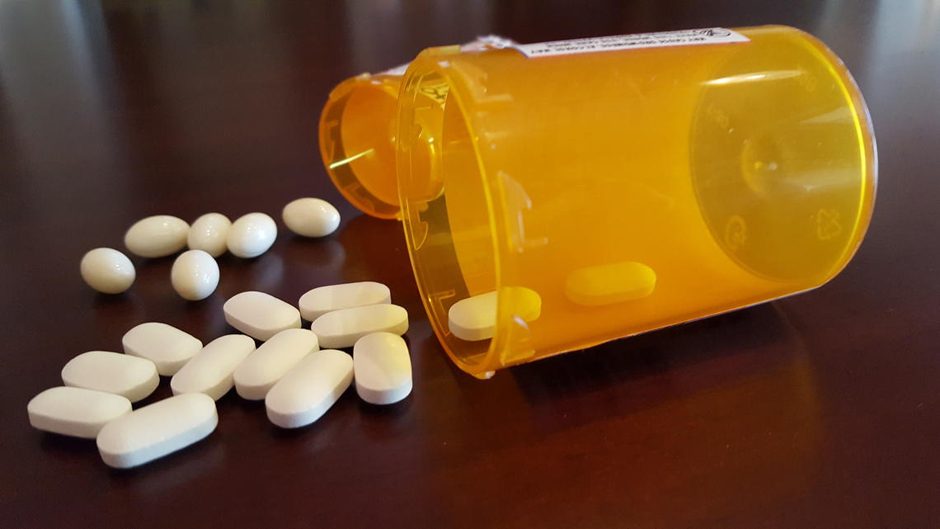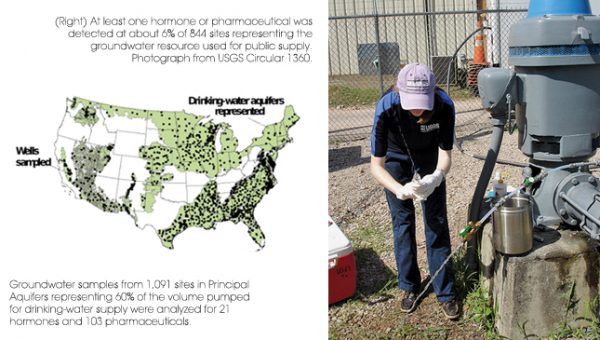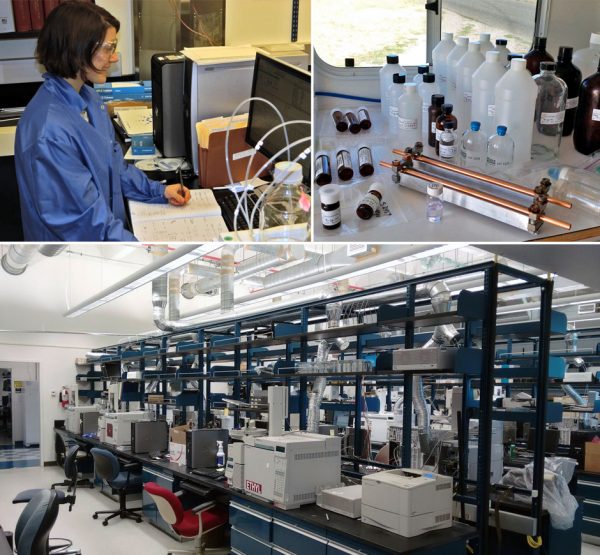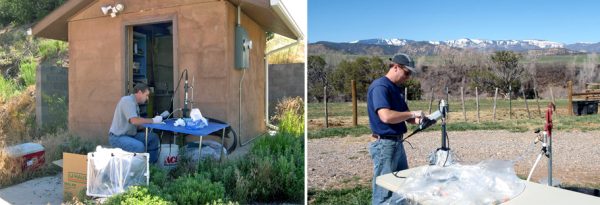USGS Monitoring Groundwater for Hormones and Pharmaceuticals

Hormones and pharmaceuticals are widely used for treatment of humans, domestic animals, and livestock, and they have the potential to enter the environment, including groundwater. Based on 2011-14 data, nearly half of Americans took at least one prescription drug in the past 30 days, and 20% took 2 or more. Annually, billions of prescriptions are filled across the U.S. (Photograph by Laura Bexfield, U.S. Geological Survey, Sept. 5, 2018)
Even at low doses, emerging contaminants can pose health risks for humans, including disruption of the endocrine system. These emerging contaminants include hormones, personal care products, perfluorinated compounds and volatile organics, and pharmaceuticals. U.S. Geological Survey (USGS) scientist Laura Bexfield presented her work on hormones and pharmaceuticals in groundwater at the 2018 Society for Risk Analysis (SRA) Annual Meeting, and more recently corresponded with EM to discuss the research.
“This is the first large-scale, systematic study of the occurrence of hormones and pharmaceuticals in aquifer systems that provide drinking-water supply for an estimated 80 million people across the US,” explains Ms. Bexfield. “The need for a comprehensive dataset for the Nation’s groundwater resources was demonstrated by foundational work led by the USGS Toxic Substances Hydrology Program, which documented multiple detections of hormones and pharmaceuticals in surface water and groundwater.”
The National Water-Quality Assessment (NAWQA) Project of the U.S. Geological Survey (USGS) is now in its third decade of collecting and analyzing data to characterize the status of, and trends in, the quality of the Nation’s streams and groundwater.

“NAWQA studies provide information about when, where, and why water quality is degraded,” details Ms. Bexfield. “NAWQA began measuring hormones and pharmaceuticals in groundwater in 2013.”
The USGS was the right Federal science agency to conduct the massive, national-scale assessment, with field personnel located across the US. Although the current study’s samples were taken from 2013 to 2015, samples have been collected at additional sites since that time.
The USGS team takes a specific sampling approach to generate spatially unbiased datasets.
“USGS personnel collected groundwater samples from 1,091 wells and springs in 46 states and 18 Principal Aquifers using nationally consistent field protocols across all sites,” Ms. Bexfield describes. “Samples were collected at or near the wellhead before any treatment or blending that potentially could alter contaminant concentrations. Each of the groundwater sites included in this study was sampled for hundreds of analytes, including hormones and pharmaceuticals, during a single visit. Sites were selected for sampling by applying equal-area sampling grids over the areas of interest, with one well randomly selected for sampling within each grid cell.”
Next, filtered samples were analyzed at the USGS National Water-Quality Laboratory for 21 hormones and 103 pharmaceuticals using methods with low detection levels of about 1 to 200 nanograms per liter (parts per trillion).

(left) Scientist measuring pharmaceutical concentrations in water samples at the USGS National Water Quality Laboratory. (Photo: Stephen L. Werner (contact Edward T. Furlong, USGS)) (right) The assortment of sample bottles used to collect groundwater for analysis of water quality, including the presence of hormones or pharmaceuticals, at each site. (Photo: Laura Hallberg, USGS) (bottom) Organics analytical section, USGS National Water Quality Laboratory, Lakewood, Colorado. (Photo: Mark Nilles, USGS)
“In particular, hormones were analyzed using solid-phase extraction and gas chromatography with tandem-quadrupole mass spectrometry (GCMS),” clarifies Ms. Bexfield. “Pharmaceuticals were analyzed using direct injection and liquid chromatography with triple-quadrupole mass spectrometry (LCMS). Rigorous quality control procedures were applied.”
Because one sample was collected at each site, this study represents more of a “snapshot” in time. However, according to Ms. Bexfield and the USGS, groundwater quality conditions generally change slowly over time, and the results of the current study can be taken as representative of the current status of the aquifers that have been sampled.
Analyzing our groundwater
The USGS team found that it is likely that individuals who get drinking water from certain wells have a higher chance of exposure to hormones and pharmaceuticals than do others.
“The findings from this study indicate that populations who obtain their drinking water from domestic wells, as compared with public-supply wells, are more likely to be exposed to hormones and pharmaceuticals, because these compounds were found more frequently in samples from domestic wells (although the study included fewer samples from domestic wells than from public-supply wells),” remarks Ms. Bexfield. “Almost all detected concentrations, however, were low compared to human-health benchmarks. The current data indicate that hormones and pharmaceuticals are more commonly detected in groundwater from shallower wells, and domestic wells typically are shallower than public-supply wells.”

Hormones and pharmaceuticals were found more frequently in samples from domestic wells (pictured here) than from public-supply wells. (Photo: USGS Circular 1357 and 1354, respectively)
It is important to note that this study examined untreated groundwater and that some hormones and pharmaceutical compounds detected in untreated source water might be present at lower concentrations—or undetected—at an individual’s tap as a result of blending, treatment, or other factors. Those factors tend to impact water from public-supply wells more often than water from domestic wells.
However, this doesn’t mean that the results of the study have dangerous implications for the health of domestic well users, or anyone else.
“Study results indicate that hormones and pharmaceuticals are generally limited in groundwater used for drinking: at least one compound was detected at about 6% of 844 sites representing the resource used for public supply and at about 11% of 247 sites representing the resource used for domestic supply,” reports Ms. Bexfield. “When present, concentrations of these compounds are unlikely to have adverse effects on human health, based on comparisons to published human-health benchmarks.”
In fact, of 34 compounds detected, only one—hydrocortisone—had a concentration greater than a human-health benchmark at one site. Most detected concentrations were several orders of magnitude below benchmarks.

(left) USGS scientist preparing to sample a public-supply well in New Mexico. (Photo: Nancy Bauch, USGS) (right) USGS hydrologic technician measures water-quality parameters for a domestic well. (Photo: Judith Thomas, USGS)
“Hormones and pharmaceuticals are not currently regulated in drinking water in the US,” adds Ms. Bexfield. “The benchmarks that are presently available from other agencies are typically based on the lowest dose of a medication that would be required to produce a clinically effective outcome, with several safety factors applied.”
Furthermore, according to the study, certain conditions make detection of these compounds more likely.
“Hormone and pharmaceutical compounds are more likely to be detected in groundwater from shallower wells with a component of recent recharge, and particularly in wells in crystalline (fractured) rocks and/or mixed land-use settings,” states Ms. Bexfield. “Hormone and pharmaceutical compounds that are more likely to be detected in groundwater used for drinking supply generally have high solubility and low tendency to absorb into soils, sediment, and rocks.”
The national-scale dataset from the published study will be publicly available online through USGS Data Releases and the USGS National Water Information System. Ms. Bexfield points out that the dataset can help decision-makers prioritize hormone and pharmaceutical compounds and environmental settings for future monitoring and research.




0 comments